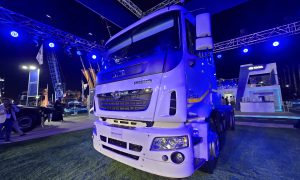Middle East gives lift to Japanese machinery firms
Weaker yen is helping manufacturers ride out volatility in global demand

Despite efforts to diversify its manufacturing base, the sales volume of many Japanese producers of construction machinery can be heavily influenced by the yen. While in the past this has led to some difficulties on the price front, in recent times a weak yen has been a boon to Japanese exports.
While $1 was as low as 75 yen in 2011, it now sits above 120, a level not seen since 2007. That means that while GCC economies see some negative effects from the higher dollar, such as lower inflows from tourists, it gives them good purchasing power when it comes to imports, whether cranes, bulldozers or excavators.
Komatsu is the unrivalled powerhouse among Japanese kit sellers, and in the financial year ending March 2015 managed to grow its sales by 1.3% to $16bn, during a period when many of its competitors saw sales fall, with difficult market conditions, especially in mining. This growth was due to the depreciation of the yen against its major trading partners, the dollar, euro and renminbi. In unit terms, Komatsu sales dropped, due to “slack demand” for construction equipment in emerging countries and for mining equipment.
In the Middle East, sales grew 9.8% to hit $493m, up from $449m the previous year, making the Middle East the best-performing region in Komatsu’s basket of strategic markets. According to its annual report, demand in Turkey, the region’s major market, was slack. Nevertheless, while crude prices dropped sharply, demand in the Gulf advanced steadily, particularly in Saudi Arabia, Qatar and the UAE, and sales increased from the previous fiscal year.
Globally, while demand declined for new construction and mining equipment, Komatsu sold a record number of after-market parts and captured a greater share of the market. The company expects demand for parts to continue to grow due to its large machine population, and is expanding its product mix of strategic parts, such as buckets, teeth and track shoes, as well as attachments.
It is also hoping to improve the efficiency of spare parts delivery, with a new parts operation model first implemented in its Kanto Spare Parts Distribution Centre, opened in August last year. Komatsu plans to introduce the upgraded operations model to its 18 other major parts distribution centres around the world, in a bid to reduce spare parts inventories. It will also strengthen its Reman (remanufacturing of components and their sales) supply operation.
The firm is continuing to invest in smart technology, such as machine control and telematics; its telematics programme, KOMTRAX, has now been mounted on over 370,000 units.
Tadano revenues in the year ended March 31, 2015 passed $1.6bn (200bn yen) for the first time, as net sales grew 12.3%. Mobile cranes made up roughly two thirds of sales volume.
In the Middle East, Tadano’s sales were $138m, a slight drop from their high in the full year 2013 of $147m, but a strong performance given the long-term trend. In the year ending April 2013, their sales were just $81m.
By its own estimation, Tadano’s share of the global market for hydraulic mobile cranes grew from 26.9% to 31.4%, excluding Chinese and Russian production. In the Middle East, Tadano calculated demand to be 878 units, made up of truck cranes (67 units), rough-terrain cranes (522 units) and all-terrain cranes (289 units), again excluding Chinese sales. With sales of 372 units, Tadano’s share of sales of mobile hydraulic cranes in the Middle East sits at 42.4%.
The company has the long-term goal of becoming the number one company in the lifting equipment (LE) business, and boosting its overseas sales to around 80% of its total volume. A recent briefing on FY 2014 financial results noted some of the difficulties for the lifting industry, including high volatility for demand in the short and medium term, despite long-term growth.
It also noted low spare parts sales: in 2014, its part sales ratio was just 6.3%, low compared with brands selling earthmoving equipment. In the same period, Komatsu had a parts sales ratio of 19.6%, and Hitachi Construction Machinery (HCM) had a ratio of 21.4%.
Despite tough global conditions, HCM managed to grow its annual sales by 1.6%, hitting $6.6bn. In the Middle East, the firm has focused on increasing sales mainly from infrastructure-related projects in the Gulf and in Turkey, and it was able to grow sales by 11.7%, to $174.4m.
Hitachi expects market demand for hydraulic excavators to fall 7% in the current year, compared with growth of 9% in the 2014 fiscal year (ending 31 March, 2015). That’s in line with the company’s predictions for total global demand this year, which it expects to fall by 7%; bucking that trend will be India and Oceania, while most of the other markets will decline.
In 2014, JV Tata Hitachi Construction Machinery (THCM) began shipping its GI series of hydraulic excavators to the Middle East and Africa, with 80 units shipped. This year it expects as many as 200 to be sold in the MEA region.
Kobelco Cranes reported strong results for the Middle East: 40% sales growth in the Middle East for its 2014 fiscal year, ending 31 March, 2015. The company noted the exchange rate averaged 109.76 yen to the dollar during the 2014 fiscal year. The high growth in Middle East sales came as a result of demand from an increased number of energy-related projects, although Kobelco’s “absolute number” of sales is not high, said the company.
Kobelco Cranes shipped close to three thousand units over the 12 months, with 500 cranes sold in Japan (an increase of 20% over the previous year), and 2,400 shipped to overseas markets, where the brand recorded growth of 10%.
The main growth areas were APAC (Asia-Pacific), with 20% growth, and North America, with 10% growth. Sales were “steady” in Europe and North America, while in China, which accounts for roughly 35% of the world market, sales declined by 10% as the expected economic recovery was delayed.
With total sales of $596.5m, Kobelco Cranes estimates its market share to be roughly 30% of the global market for crawler cranes, including its OEM supply agreement with Manitowoc.
There may also be a merger on the horizon for the two Kobelco companies, Kobelco Cranes and Kobleco Construction Machinery, which produces hydraulic excavators. Both are owned by Kobe Steel. A recent release said that consideration was being given to a merger, while at the same time stating that the consideration would have the aim of “integrating the two companies on April 1, 2016”. With joint revenues of around $3.24bn (400bn yen), they account for 20% of Kobe Steel’s total sales.
While the United States is the key target market for Kobelco Excavators, with the company deciding to build a new excavator plant there last year, the Middle East is also a focus. “Establishing a presence in the global market – including India, the Middle East and other emerging countries and regions where demand is anticipated to grow – is an urgent issue for Kobe Steel’s construction equipment business,” said the company in its release.
Komatsu sells 55 super-large dumpers
With the global mining industry in a major cyclical downturn, companies are cutting back heavily on capital spending. This is having a big effect on producers of large mining equipment, especially the big guns – Komatsu, Hitachi CM and Caterpillar.
Coal miners have been hit especially hard, with low prices and falling stock prices, as well as pressure from many activists and large institutional investors to divest from coal due to concerns about its role in climate change.
But due to the demanding nature of the mining industry, miners are still having to invest in spare parts, and even in new equipment. Komatsu recently announced the sale of 55 super-large dump trucks to Adani Mining, which operates the Carmichael coal mine in Queensland, Australia. The 960E-2 and 930E-4SE units are slated for delivery from the second half of 2016.
When operational, the Carmichael coal mine will be one of the world’s largest. Adani Mining in Australia is part of the Indian Adani conglomerate and the Carmichael project is part of the Adani Group’s large project to bring the energy supply chain of mine, railway, ports, shipping and electricity production in India together in one conglomerate.
The mine is expected to deliver 10,000 jobs and $17bn in taxes and royalties over the half life of the projects.

























